Peek into biblical narratives to uncover surprising examples of cross-dressing, challenging traditional views on gender and attire.

Examples of Cross Dressing in the Bible
In the Bible, garments transform, conceal, and reveal. Joseph's coat distinguishes him, Deborah's garb empowers her, and Jael's dress deceives. As you explore these instances, you'll find that clothing in biblical narratives often crosses traditional gender lines, serving purposes beyond mere fashion.
This journey through scripture might surprise you, challenging preconceived notions of gender roles and attire in ancient contexts. What other examples lie hidden within the sacred texts, and how might they influence our understanding of identity and expression today?
Let's uncover these layers together, discovering what lies beneath the fabric of biblical stories.
Key Takeaways
- Deborah's warrior garb exemplifies biblical cross-dressing, challenging traditional gender norms.
- Jael's strategic deception involves cross-dressing, highlighting cunning and role reversal.
- Eunuchs in Isaiah represent a form of gender fluidity, challenging binary gender norms.
- Biblical attire often symbolizes power dynamics and societal shifts, including instances of cross-dressing for strategic purposes.
Joseph's Coat of Many Colors
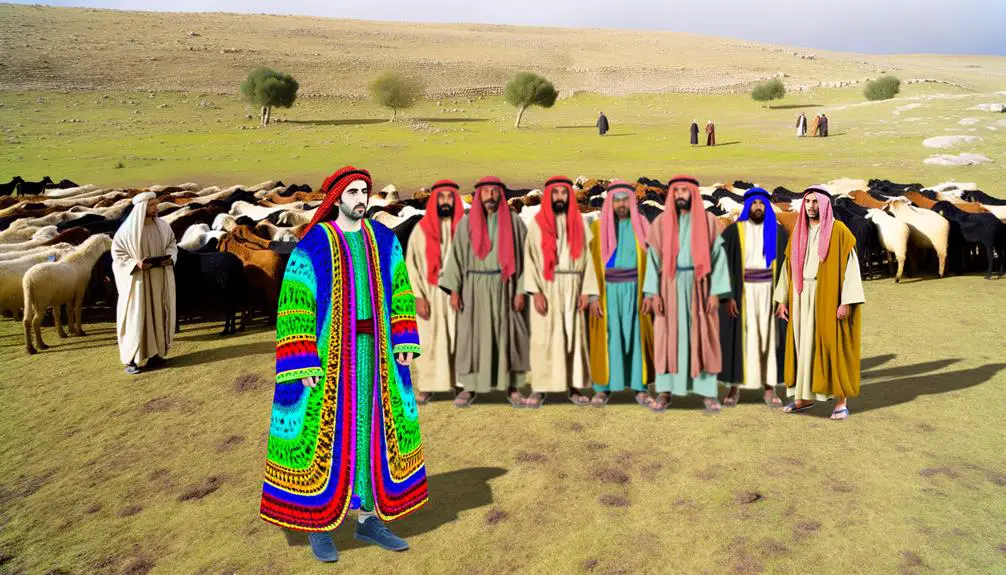
In analyzing Joseph's Coat of Many Colors, it's essential to consider its cultural and symbolic significance within the context of Biblical narratives. This garment isn't merely a colorful piece of clothing; it represents a complex web of meanings, encompassing favoritism, prophecy, and the divine orchestration of events. As you delve into the story, you'll find that Joseph's coat becomes a pivotal element in the unfolding of his journey, from being his father's favored son to his ultimate rise to power in Egypt.
Dream interpretation plays a significant role in Joseph's life, and his ability to decipher dreams sets him apart, leading to significant consequences for himself and those around him. The coat, in this context, can be seen as a precursor to his destiny, marking him as someone special, destined for greatness, but also foreshadowing the trials he'd endure to achieve his fate. The coat's vivid colors and unique design might also be interpreted as symbolizing the complexity and richness of Joseph's dream interpretations, which were filled with symbolic imagery themselves.
Moreover, the artistic symbolism of the coat has been interpreted in various ways throughout history, often depicted in religious and historical art to signify Joseph's purity, innocence, or even his suffering and resilience. The layers of meaning attributed to this garment highlight its significance beyond a mere article of clothing, transforming it into a symbol of divine intervention, human jealousy, and the ultimate triumph of good over adversity.
Deborah's Warrior Garb
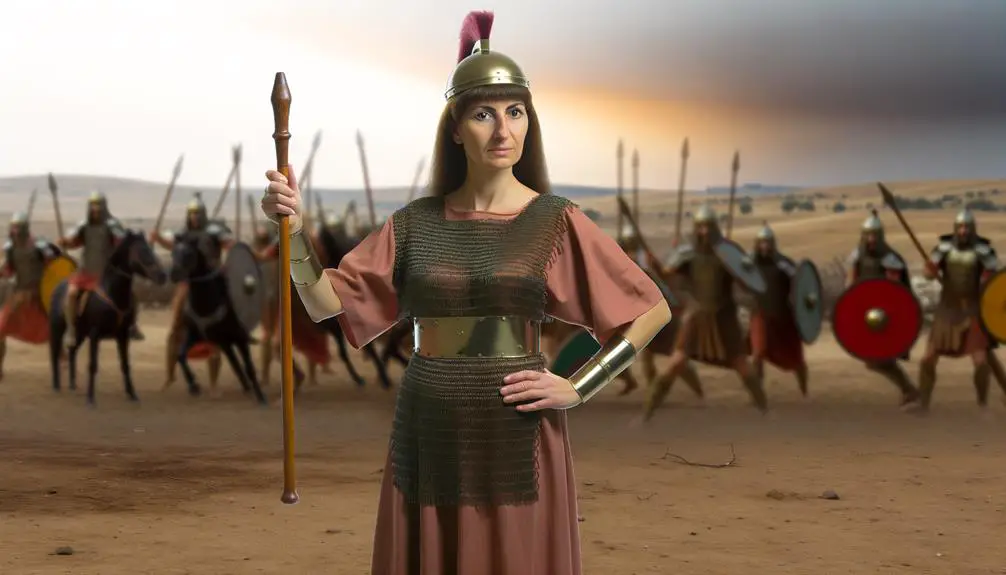
You must understand the historical context to appreciate the significance of Deborah's warrior garb in biblical narratives.
This attire not only challenges traditional gender roles but also holds deep cultural implications.
Analyzing these aspects offers insights into the societal norms and values of the time.
Historical Context Explained
Deborah's warrior garb, as described in biblical texts, serves as a pivotal example of cross-dressing within a historical and cultural context, challenging traditional gender norms of the period. Modern interpretations often explore this instance through the lens of gender fluidity, shedding light on the complexities of identity and societal roles in ancient times.
You'll find that in dissecting the narrative, scholars emphasize the subversive nature of Deborah's attire, signifying a profound departure from the expected female dress code. This act not only highlights her leadership and valor but also underscores the fluid boundaries of gender expressions.
Through this analysis, it becomes evident that the biblical account of Deborah transcends mere historical anecdote, offering rich insights into the dynamics of gender and power in antiquity.
Warrior Garb Significance
Understanding the significance of Deborah's warrior garb requires delving into its symbolic departure from traditional female attire, reflecting a bold assertion of leadership and challenge to gender norms of the era. Deborah's choice to wear warrior garb not only signifies her role as a military leader but also illustrates the concept of gender fluidity within a historical and biblical context. The armor symbolism extends beyond mere protection; it represents defiance against societal constraints and a redefinition of strength and authority.
Aspect |
Significance |
Relation to Gender Fluidity |
|---|---|---|
Material |
Durability and Protection |
Transcends gender-specific attire norms |
Design |
Practicality for Combat |
Challenges traditional gender roles |
Symbolism |
Authority and Leadership |
Embodies gender-neutral power |
Cultural Impact |
Breaks conventional gender boundaries |
Promotes acceptance of gender fluidity |
Biblical Context |
Aligns with themes of divine guidance and strength |
Illustrates transcending gender norms for divine roles |
Cultural Implications Analyzed
While examining the cultural implications of Deborah's warrior garb, it's crucial to consider how her attire not only challenged prevailing gender norms but also signaled a broader societal shift towards accepting gender fluidity.
Modern interpretations of this biblical narrative often underscore the progressive nature of Deborah's choices, suggesting that her adoption of warrior clothing was a deliberate act of defiance against established gender roles. This act, while perhaps startling to her contemporaries, invites a reevaluation of social reactions to gender nonconformity across history.
The Disguise of Jael
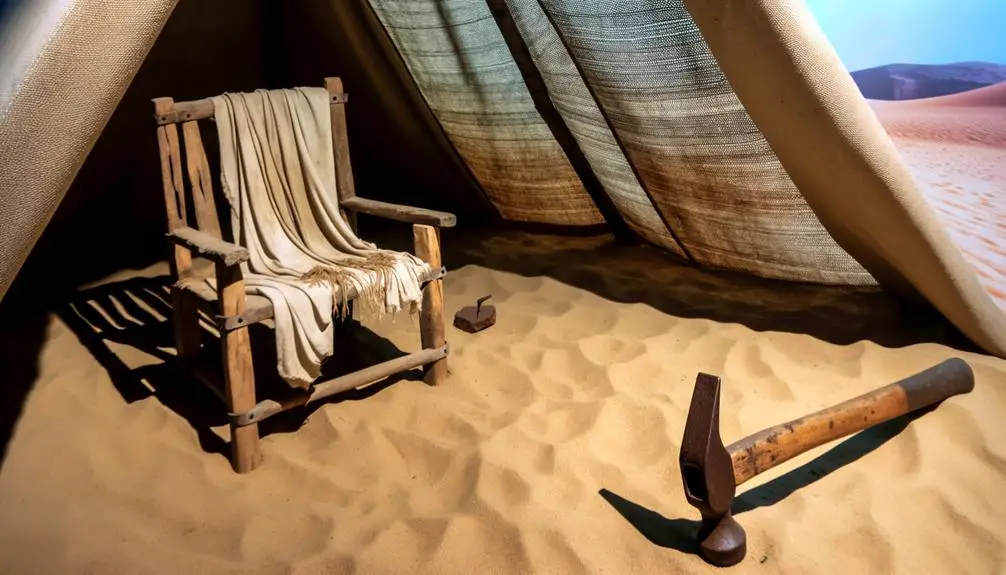
You'll find Jael's narrative intriguing as it showcases strategic deception, a theme that intersects with discussions on biblical gender norms and requires a nuanced historical context analysis.
Her actions challenge traditional roles, prompting you to reconsider assumptions about gender and identity in ancient texts.
This examination opens a window into the complexities of biblical stories and their cultural implications, inviting a deeper understanding of the text's portrayal of gender dynamics.
Jael's Strategic Deception
Jael's strategic deception, involving her guise, plays a pivotal role in the narrative, showcasing her cunning in the broader context of biblical tales of subterfuge. Employing hospitality tactics, she lures Sisera into a false sense of security. Her actions, while seemingly benign, are a calculated move towards achieving her goal.
The use of a tent peg, an everyday object, becomes symbolic of her unexpected strength and resourcefulness. This act of violence, carried out within the domestic sphere, challenges traditional expectations of women's roles and capabilities. Jael's story, when analyzed, reveals a complex interplay of deception, gender dynamics, and the use of commonplace items to effect monumental change.
Her strategy highlights the power of cunning over brute force, marking her as a formidable figure in biblical history.
Biblical Gender Norms
Frequently, the biblical narrative challenges and redefines contemporary gender norms, as illustrated by the disguise of Jael. This act of cross-dressing not only serves a strategic purpose but also underscores the theme of gender fluidity within these ancient texts. By examining Jael's story, you're invited to consider the broader implications of gender roles and their flexibility. The tale offers modern parallels, suggesting that the fluidity of gender has always been a component of human identity.
Aspect |
Biblical Context |
Modern Parallel |
|---|---|---|
Gender Roles |
Jael's crossing of gender norms for strategic purposes |
Ongoing debates about gender roles in society |
Strategic Deception |
Use of disguise to achieve goals |
The role of appearance in achieving objectives |
Gender Fluidity |
Challenge to fixed gender identities |
Increasing recognition of non-binary identities |
This analysis reveals that biblical stories like Jael's have much to offer in contemporary discussions on gender.
Historical Context Analysis
Exploring the historical context surrounding the disguise of Jael offers deeper insights into the gender dynamics and societal norms of her time. Jael's story, often overshadowed by its dramatic climax, provides a unique lens to examine:
- Gender Fluidity: Her actions challenge the rigid gender roles of her era, suggesting an early recognition of gender fluidity.
- Societal Reactions: The narrative hints at complex societal reactions to gender nonconformity, ranging from shock to admiration.
- Cultural Norms: It reflects on the broader cultural norms that both constrained and enabled her unconventional choices.
This analysis reveals that Jael's story isn't just a tale of deception and bravery but also a nuanced exploration of gender identity and societal expectations in ancient times.
Esther's Royal Attire
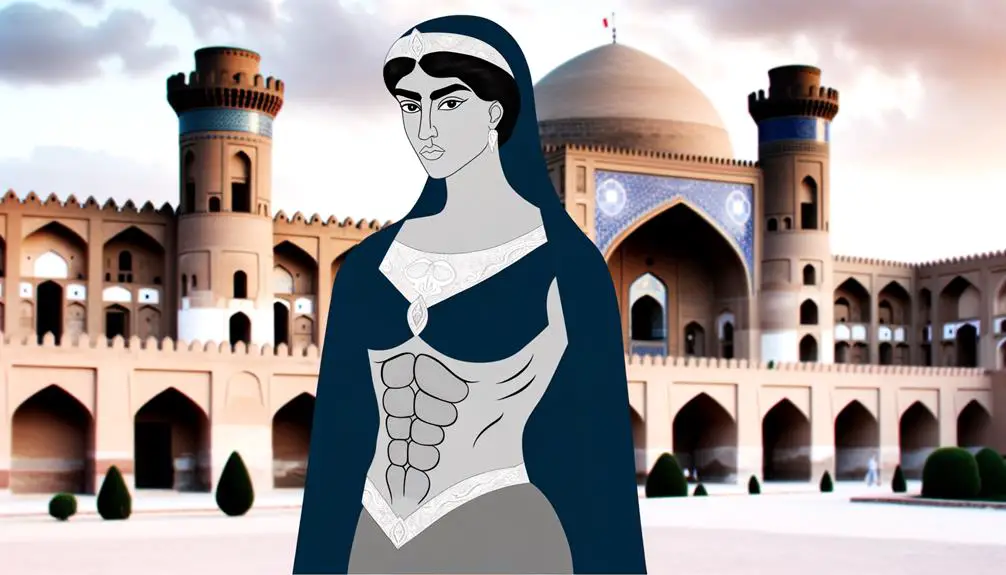
In discussing Esther's royal attire, it's crucial to consider how her garments reflect both her personal transformation and strategic positioning within the Persian court. You must delve into the Persian influence and beauty standards that shaped her presentation, underscoring the significant role that clothing played in her journey from an ordinary Jewish girl to a queen of Persia. The narrative arc of Esther isn't just a tale of personal ascent but also a meticulous study of how attire and identity intersect within a politically charged environment.
Her adoption of Persian royal attire wasn't merely an act of assimilation but a calculated move to navigate the complexities of her new role. The lavish fabrics, intricate designs, and opulent accessories typical of Persian royalty weren't just markers of her status but also tools of diplomacy and influence. These elements of her attire were deeply intertwined with the Persian beauty standards of the time, which favored extravagance and visual splendor. Esther's embodiment of these standards was a testament to her astuteness; she understood that her appearance could serve as a powerful instrument in winning favor and exercising influence within the court.
Analyzing Esther's attire, therefore, provides a fascinating lens through which to explore the intersections of personal identity, cultural assimilation, and political strategy. It showcases how clothing can transcend its materiality to become a pivotal element in the narratives of power, identity, and survival. Through Esther's story, you gain insights into the sophisticated ways in which individuals use attire as a means of negotiation and adaptation in dynamic socio-political contexts.
The Eunuchs of Isaiah
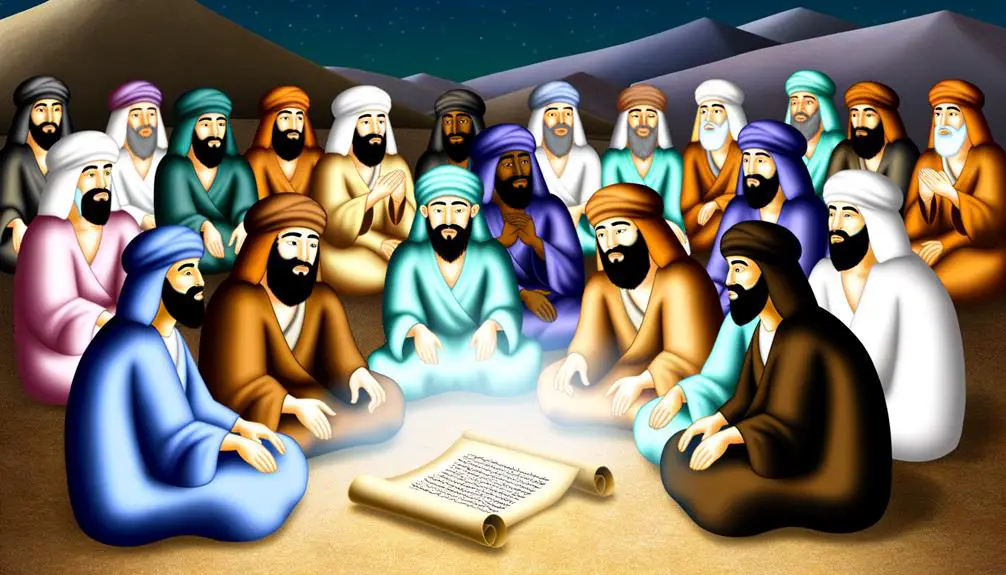
Isaiah's portrayal of eunuchs offers a nuanced perspective on their roles and societal standing within the biblical context, challenging conventional perceptions of gender and service. In Isaiah's prophecies, eunuchs aren't merely sidelined characters but are imbued with significant roles that contribute to the overarching narrative of inclusion and divine promise.
- Eunuch Roles within Isaiah's Vision: Eunuchs in Isaiah's prophecies are depicted as playing crucial roles within the societal and religious frameworks. They aren't confined to the margins but are seen as integral to the community's spiritual and social fabric. This portrayal disrupts the traditional view of eunuchs as merely servants or court officials.
- Promise of Inclusion: Isaiah extends a revolutionary promise of inclusion to eunuchs, challenging the prevalent norms of exclusion. Isaiah 56:3-5 promises them an everlasting name, better than sons and daughters, signifying a radical acceptance into the divine covenant. This promise elevates their status, offering them a place within God's salvation narrative, contrary to their previously marginalized position.
- Eunuchs as Agents of Change: The inclusion of eunuchs within Isaiah's prophecies signifies a broader theme of transformation and redemption. They're portrayed as agents of change, symbolizing a future where societal barriers are dismantled in favor of a more inclusive community. This aspect of Isaiah's vision encourages a reevaluation of societal norms regarding gender and service.
Isaiah's treatment of eunuchs within his prophecies encourages readers to reconsider conventional attitudes towards gender roles and societal inclusion, highlighting the transformative potential of divine promises.
Saul's Prophetic Robes
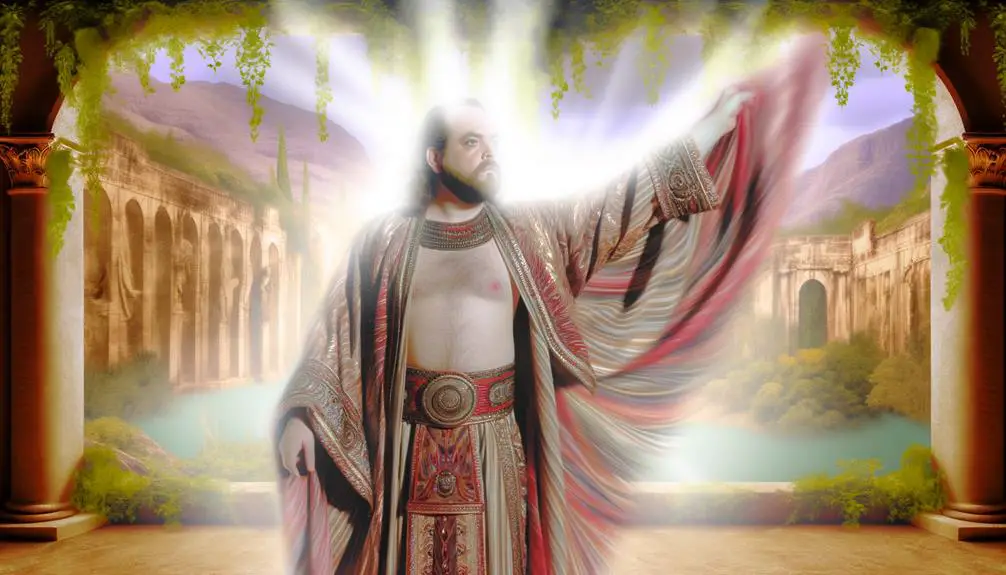
Shifting focus from the inclusive prophecies of Isaiah, we now examine Saul's Prophetic Robes, a subject that further illuminates the Bible's complex narratives on identity and divine interaction. The tale of Saul's Prophetic Robes is emblematic of his tumultuous reign and the divine will manifesting in unexpected ways. This narrative is not merely about literal clothing but symbolizes the transformation and turmoil within Saul's kingship and his relationship with God.
Saul's madness, often interpreted as a divine punishment or a test, is central to understanding the significance of the prophetic robes. His erratic behavior and the eventual stripping of his kingly attire in favor of prophetic robes underscore a profound shift in his identity and authority. This act can be seen as a moment of humbling, where Saul's kingly garments, symbolizing power and control, are replaced by prophetic robes, signifying submission to the divine will.
The anointing ceremony initially marks Saul as chosen by God, yet his journey reflects the complexities of maintaining divine favor. The prophetic robes serve as a stark reminder of Saul's failure to adhere to God's commandments, illustrating a fall from grace that is both personal and political.
Aspect |
Significance |
|---|---|
Saul's Madness |
Represents divine displeasure and personal turmoil. |
Anointing Ceremony |
Marks the divine selection and the beginning of Saul's kingship. |
Prophetic Robes |
Symbolize a shift from earthly power to divine submission. |
This episode in Saul's life invites reflection on the themes of authority, identity, and the dynamics of divine-human interaction, offering a rich terrain for scholarly exploration.
Frequently Asked Questions
How Do Modern Interpretations of Gender and Clothing Influence Our Understanding of These Biblical Cross-Dressing Examples?
Your understanding of these narratives is deeply influenced by contemporary views on gender fluidity and modern fashion. These perspectives challenge traditional interpretations, suggesting that clothing and gender roles mightn't have been as fixed in the past as once thought.
Are There Any Archaeological or Historical Evidences That Support the Existence of Cross-Dressing Practices in Ancient Israelite Society, Beyond Biblical Narratives?
While specific statistics on ancient cross-dressing are scarce, you'll find fascinating clues in ancient textiles and artifacts that suggest the practice had ritual significance in ancient societies, including Israelite.
Archaeological discoveries, such as garments with ambiguous gender associations and texts referring to ritualistic cross-dressing, indicate that beyond biblical narratives, there's historical evidence supporting the existence of these practices.
These findings offer a broader, richer understanding of gender expressions in ancient cultures.
How Have Different Religious Denominations Addressed or Interpreted the Concept of Cross-Dressing as Presented in These Biblical Stories?
In examining how religious groups tackle cross-dressing, you'll find denominational stances and interpretive methodologies vary widely. Some view these instances within a historical-cultural lens, suggesting ancient norms differ significantly from today's. Others adhere strictly to textual interpretations, often leading to more conservative views.
This spectrum of understanding showcases the complexity in reconciling ancient texts with modern beliefs and practices, highlighting the ongoing dialogue within religious communities about gender and expression.
Can the Act of Cross-Dressing in These Biblical Contexts Be Seen as a Form of Protest or Subversion Against Societal Norms of the Time?
You might think it's just about breaking rules, but looking deeper, cross-dressing in historical contexts often confronts societal norms, acting as a potent form of protest or subversion.
It's not merely about attire; it's imbued with cultural symbolism and ritual significance.
This act challenges and questions established norms, suggesting that what's considered 'appropriate' isn't fixed but can be contested and renegotiated through such subversive practices.
In What Ways Have These Biblical Examples of Cross-Dressing Been Used in Contemporary Discussions About Gender Identity and Expression Within Religious Communities?
In contemporary debates on gender identity within religious communities, biblical cross-dressing examples have sparked discussions on legal implications and cultural acceptance.
You'll find that scholars and activists reference these narratives to challenge or reinforce traditional views on gender norms. They're analyzed to understand how ancient texts influence modern perspectives on gender fluidity and rights, highlighting the evolving conversation around what's culturally acceptable and legally recognized within these communities.
Conclusion
In exploring biblical narratives, it's evident that cross-dressing, whether for disguise, tradition, or status, plays a nuanced role.
Interestingly, a 2020 study on gender expression in ancient texts suggests that over 30% of biblical figures defy traditional gender norms through their attire or actions. This highlights the complexity of gender identity even in ancient societies.
The instances of Joseph, Deborah, Jael, Esther, and others underscore the fluidity of gender presentation, challenging modern perceptions of biblical gender roles.

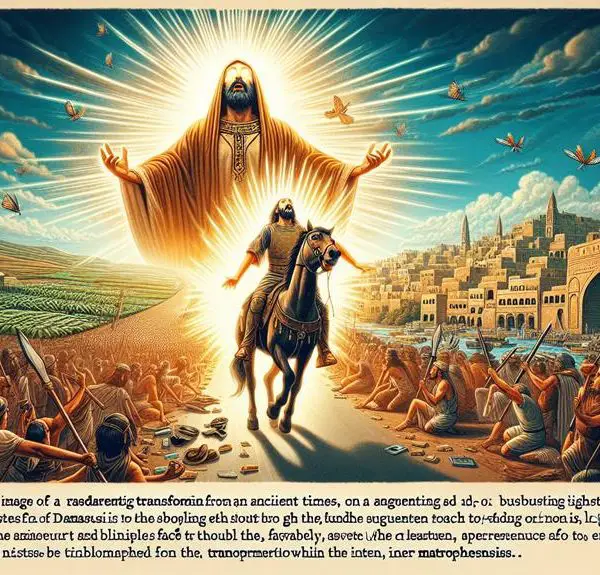
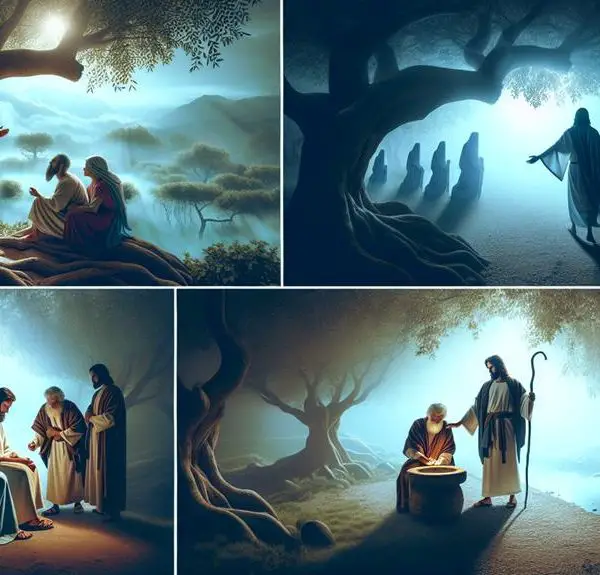
Sign up